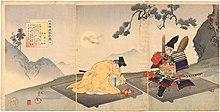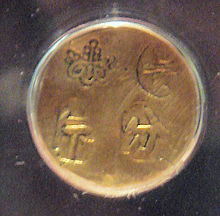Takeda clan
This article has multiple issues. Please help improve it or discuss these issues on the talk page. (Learn how and when to remove these template messages)
|
| Takeda clan 武田 | |
|---|---|
mon) of the Takeda clan | |
| Home province | Kai |
| Parent house | |
| Titles | Various |
| Founder | Minamoto no Yoshikiyo |
| Final ruler | Takeda Katsuyori |
| Current head | None |
| Founding year | 12th century |
| Ruled until | 1582, defeat by Oda Nobunaga |
| Cadet branches | Aki Takeda Wakasa Takeda Kazusa Takeda Matsumae clan Nanbu clan Yonekura clan Yanagisawa clan Gotō clan Ogasawara clan Miyoshi clan Akiyama clan |
The Takeda Clan (武田氏, Takeda-shi) was a Japanese samurai clan active from the late Heian period until the late 16th century. The clan was historically based in Kai Province in present-day Yamanashi Prefecture.[1][2] The clan reached its greatest influence under the rule of Takeda Shingen, one of the most famous rulers of the period.
History
Origin

The Takeda are descendants of the
Kamakura to early Azuchi–Momoyama periods
In the 12th century, at the end of the Heian period, the Takeda family-controlled
Sengoku period
Immediately prior to the Sengoku period, the Takeda helped to suppress the Rebellion of Uesugi Zenshū (1416–1417).[5] Uesugi Zenshū (d. 1417) was the kanrei chief advisor to Ashikaga Mochiuji, an enemy of the central Ashikaga shogunate and the Kantō kubō governor-general of the Kantō region. Mochiuji, lord of the Uesugi clan, made a reprisal against the Takeda clan in 1415. This reprisal began a rivalry between the Uesugi and Takeda clans which would last roughly 150 years until the destruction of the Takeda clan at the end of the Sengoku period.[6] While this rivalry existed, the Takeda and the Uesugi still had a huge amount of respect for one another.
Takeda Shingen

Shingen is famous for his tactical genius, and innovations, though some historians have argued that his tactics were not particularly impressive nor revolutionary. Nevertheless, Shingen is perhaps most famous for his use of the cavalry charge at the Battle of Mikatagahara. The strength of Shingen's new tactic became so famous that the Takeda army came to be known as the Kiba Gundan (騎馬軍団), or 'mounted army'. Up until the mid-16th century and Shingen's rise to power, mounted samurai were primarily archers. There was already a trend at this time towards larger infantry-based armies, including a large number of foot archers. In order to defeat these missile troops, Shingen transformed his samurai from archers to lancers.
Decline of the Takeda clan

Shingen died on May 13, 1573, at age 53 from illness.[8][7] His son Takeda Katsuyori (1546–1582) effectively succeeded Shingen though the nominal head of the family was his grandson Takeda Nobukatsu; Katsuyori continued Shingen's aggressive expansion plan south and westward and was initially successful, briefly achieving the largest extent of Takeda rule. However, he was defeated in the Battle of Nagashino in 1575 by Oda Nobunaga and Tokugawa Ieyasu.
After Nagashino, the Takeda clan fell into sharp decline as it had lost many of its most notable samurai during the battle. Katsuyori's position within the clan also became precarious (as he did not fully inherit the clan leadership position); in 1582, two of his relatives defected to the Oda/Tokugawa alliance and Nobunaga succeeded in destroying the Takeda clan shortly thereafter. The campaign saw most of the Takeda followers simply abandoning Katsuyori and the other Takeda family members to their fate. The clan was effectively eliminated, although descendants of the Takeda clan would take prominent positions in the Tokugawa shogunate, established in 1603.[7]
Modern period


Takeda is also a fairly common family name in modern Japan, though it is unlikely that everyone with the Takeda name is descended from this noble house (several divisions of the family have the Takeda name).
In fact, most of the real descendants of the Takeda had a different name when they created a cadet branch. It is also acknowledged that members of the clan married into other Japanese families.
During the
- The Hokkaidō.
- The Nanbu, descendants of Takeda Mitsuyuki (1165-1236), grandson of Takeda Kiyomitsu (1110-1168), established himself at Nambu (Kai Province) and took that name. The Nambu were daimyō of Morioka, of Shichinohe and Hachinohe (Mutsu Province).
- The Yanagisawa, descendants of Takeda Nobunaga, a grandson of Takeda Nobuyoshi (1128-1186), were daimyō of Kōriyama (Yamato Province), of Kurokawa and Mikkaichi (Echigo Province).
- The Yonekura, descendants of Takeda Kiyomitsu, settled at Koiwasuji Yonekura and took the name Yonekura. They were daimyō of Mutsuura Domain (Musashi province)
- The Gotō, descendants of Takeda Nobuhiro, were daimyō of Gotō (the Gotō Islands in Hizen Province).
- The Ogasawara are also a cadet branch of the Takeda, by Takeda Nagakiyo (1162–1242), grandson of Takeda Kiyomitsu (1110-1168), and the first to take the name of Ogasawara. His descendants were shugo (governors) of Shinano and Hida Provinces, and during the 16th century were at war with their Takeda cousins. In 1868, they were daimyō of Kokura, of Chikuza (Buzen Province), of Ashi (Harima Province), of Karatsu (Hizen Province), and of Katsuyama (Echizen Province).
In 1868, two branches named Takeda were also ranked among the Kōke (the High Families). This title was given to descendants of great dispossessed daimyo families of the Kamakura period to Sengoku period such as the Takeda, the Kyōgoku, the Rokkaku, the Ōtomo, the Toki, the Isshiki and the Hatakeyama clans. They received a pension from the shogunate and had privileged missions confided to them.
Cadet branches

Three major cadet branches of the Takeda clan were established across Japan, along with several smaller branches. Due to the establishment of these cadet branches, the main Takeda clan in Kai Province is also referred to as the Kai Takeda clan.
Aki Takeda
The
Wakasa Takeda
The Aki Takeda was granted the governorship of Wakasa province in 1440. The Wakasa Takeda clan was established in Wakasa Province in present-day southern Fukui Prefecture, and separates from Aki province in 1500, when Takeda Motonobu (1461-1521) ruled Wakasa, while his uncle Takeda Mototsuna (1441-1505) ruled Aki.[1] The Wakasa Takeda were known for their patronage of the arts and developing the Takeda school of military etiquette.[2]
Kazusa Takeda
The Kazusa Takeda clan, established at the beginning of the Sengoku period in Kazusa Province in the present-day central area of Chiba Prefecture. Along with the Satomi clan of Awa Province in the southern part of present-day Chiba Prefecture the two clans replaced the dominance of the Chiba clan in the region. The Kazusa Takeda is also known as the Mariyatsu Takeda, a reference to their base of power, Mariyatsu Castle.[1]
Clan literature
The Kōshū Hatto, composed at some point in the 15th century, is the code of law of the Takeda family,[9] while the Kōyō Gunkan, composed largely by Kōsaka Masanobu in the mid-16th century, is an epic poem recording the family's history and Shingen's innovations in military tactics.
Notable figures of the Takeda clan
Among the notable members of the Takeda clan was Takeda Nobushige, who wrote the Kyujukyu Kakun, which introduced the 99 rules for the clan members.[10] Takeda Nobumitsu, who was a noted warrior under the Hojo shikken of Kamakura, became a monk and founded the Takeda family of Kai.[11] Another important figure was Minamoto no Yoshimitsu, who developed the Daito-ryu Aikijujutsu/Takeda-ryu.[12] Other noted members include Nobuyoshi, Nobutora, Harunobu (Shingen), Katsuyori, Matsuhime
Important members
- Takeda Nobutora – Shingen's father
- Takeda Shingen – one of Japan's most famous warlords, Shingen expanded his domains greatly and became one of the major powers in the country for a time.
- Takeda Katsuyori – Shingen's son, Katsuyori commanded his father's armies after his death, and saw the fall of the Takeda family.
- Matsuhime – Shigen's daughter
- Takeda Nobushige – Shingen's younger brother, who held their father's favor to be heir of the clan, continued to support his older brother throughout his life, he also wrote the Kyūjūkyū Kakun, a set of 99 short rules for Takeda house members.
- jūjutsu, and the first to teach the art outside of the Takeda family.[13]
Crests
- Four diamonds (pictured)
- Four diamonds surrounded by a solid ring
- Two cranes bowing their heads together
- A centipede
- Hanabishi (three vertical flowers)
- Fūrinkazan (a battle standard with the writing: "風林火山", which literally means: "Wind, Forest, Fire, Mountain".)
- The Tai (大) character
Popular culture
Takeda is a playable faction in
Takeda is a playable nation in Europa Universalis IV.
The Takeda clan in feudal Japan is in the manga and the anime of Inuyasha.
Takeda Shingen and his peasant doppelgänger are the main subjects of Kagemusha, directed by Akira Kurosawa.
The character Miku Nakano from the anime and manga series The Quintessential Quintuplets is shown to have an obsession with Takeda Shingen.
References
- ^ a b c d "Takeda-shi (武田氏)". Kokushi Daijiten (国史大辞典) (in Japanese). Tokyo: Shogakukan. 2012. Archived from the original on 2007-08-25. Retrieved 2012-05-09.
- ^ a b "Takeda family". Encyclopedia of Japan. Tokyo: Shogakukan. 2012. Archived from the original on 2007-08-25. Retrieved 2012-05-17.
- ISBN 978-1-5026-2459-8.
- ISBN 978-1-4629-0344-3.
- ^ "Uesugi Zenshū, Rebellion of". Encyclopedia of Japan. Tokyo: Shogakukan. 2012. Archived from the original on 2007-08-25. Retrieved 2012-05-17.
- ^ "Uesugi family". Encyclopedia of Japan. Tokyo: Shogakukan. 2012. Archived from the original on 2007-08-25. Retrieved 2012-05-17.
- ^ a b c "Takeda Shingen". Encyclopedia of Japan. Tokyo: Shogakukan. 2012. Archived from the original on 2007-08-25. Retrieved 2012-05-17.
- ISBN 978-0-19-533126-4.
- ISBN 978-0-674-25466-4.
- ISBN 978-91-87263-02-6.
- ISBN 978-0-674-01753-5.
- ISBN 978-1-4629-0344-3.
- ^ "Takeda Sōkaku (武田惣角)". Nihon Jinmei Daijiten (日本人名大辞典) (in Japanese). Tokyo: Shogakukan. 2012. Archived from the original on 2007-08-25. Retrieved 2012-04-10.
Further reading
- Sansom, George (1961). A History of Japan: 1334–1615. Stanford: Stanford University Press.
- Turnbull, Stephen (1998). The Samurai Sourcebook. London: Cassell & Co.
- Turnbull, Stephen (2002). War in Japan 1467–1615. Oxford: Osprey Publishing.
